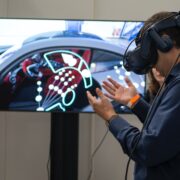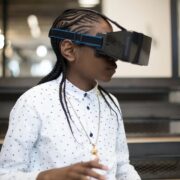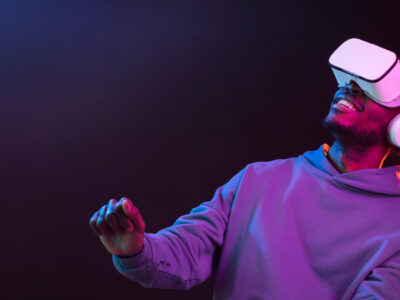Virtual reality (VR) is the next big thing in technology. It can be used for everything from gaming to education, but not everyone knows what VR is or how it works. In this article, we’re going to discuss the basics of VR and metaverse, let’s discuss the basic strong
VR has infinite potential. It’s a new medium, a way to experience the world in ways that were never possible before. It’s also a new way to communicate, interact with people and learn about new things. This is why it’s exciting for so many people around the world: because it allows us to do things we’ve never been able to do before.
Virtual Reality (VR) and the Metaverse have been hot topics in the gaming and tech industries for several years now. It’s time to put them together.
Now we have established a proper introduction we can shift to the details of the VR and Metaverse. VR and Metaverse are two of the most exciting technologies to emerge in recent years. Many believe that these two will revolutionize the way we live, work, and play. Learn the difference between VR and Metaverse.
What is VR?
VR is a computer-simulated environment that can be interacted with, and is often experienced through the use of special equipment. VR is a virtual environment that can be interacted with; it’s a simulated reality.
VR is a computer-generated environment that can be interacted with, and is often experienced through the use of special equipment.
VR has infinite potential
Virtual reality (VR) is a new medium, and as such, has infinite potential. It’s what makes it so exciting to work in. There are so many ways that we can use VR to experience the world in completely new ways! We’re moving from passive consumption of content on 2D screens or books to being able to interact with 3D objects and environments.
This interaction is happening at an unprecedented level of realism: we can interact with people face-to-face (or whatever their avatar looks like), move around freely without bumping into things or running out of battery life, and even touch objects that feel like they’re right there in front of us.
The potential for this technology goes far beyond just entertainment—VR has applications as diverse as education and training simulations that mimic real-life experiences; creative expression in immersive art installations; even mental health treatment programs using VR exposure therapy techniques.
With VR, you can travel to places you wouldn’t otherwise be able to visit—from the surface of Mars to the top of Mount Everest—without ever leaving your home. You can experience things from other people’s perspectives as if you were there yourself: take on the role of someone else and see what they see through their eyes; go into another world and learn something new about it while still being in yours; create art with others who are far away but feel close because they’re sharing the same space with you in VR. Now we shall talk about the limitations which help to distinguish between VR and Metaverse.
Limitations with VR
As we are now at the point where we have established the role of VR and metaverse. Now let’s talk about some of the limitations of VR. As you may have already realized, the best way to communicate with someone in VR is usually through voice chat. This is because body language and other cues that are crucial for effective communication are not present in VR. That being said, there are still many benefits to being able to see your coworkers and colleagues in virtual reality. However, it’s important that we don’t get too carried away with these technologies and forget about the value of face-to-face interaction!
Here is the table of VR headsets available in the market:
Comparison of Features and Specs
| VR Headset/ Specs | Weight | Screen size | Connectivity | Operating System | Field of View | Price on Amazon |
| Oculus Rift VR Headset | 1050 grams | 7 cm | Bluetooth | Android | 1000 degrees | Amazon |
| HP Reverb | 4 Kilograms | 7.34 cm | Bluetooth, Auxiliary | Windows 10 | 114 Degrees | Amazon |
| HTC VIVE PRO | 470 grams | 3.5″ | USB 3.0 cable | Windows® 7 SP1, Windows® 8.1, Windows® 10 | 110 degrees | Amazon |
| Lenovo Explorer | 380 grams | 2 x 2.89″ | Y Cable with video connection and USB 3.0 3.5 mm audio jack | Windows 10 | 110 degrees | Amazon |
| Pimax Vision 5k | 500 g without head strap 750 g with head strap | 6 inches | Audio Jack (3.5mm) | Windows 8.1, 10 | 150-200 degrees | Amazon |
| Valve Index | 809g | 6 Inches | USB | Windows, Linux | 20 Degrees | Amazon |
| GOOVIS Young Personal Immersive 4K Headset | 200g | 2×0.71″ | Wired, HDMI | Android | + 3D to -8D | Amazon |
| Samsung HMD Odyssey | 1.42 pounds | 2 x 3.5″ AMOLED | USB, HDMI | Win10 RS3 | 110 Degrees | Amazon |
| Oculus Quest 2 | 503 g | LCD 1832 x 1920 | USB-C cable, bluetooth, WiFi | Android 10 | 89 Degrees | Amazon |
| Sony PlayStation VR | 600 g | 5.7 inches | HDMI and USB | 100 Degrees | Amazon |
Now let’s move to the other side of the court, Let’s clear out the clouds regarding Metaverse:
What is a Metaverse?
A metaverse is a virtual space that evolves as it grows. It’s inhabited by characters, often called avatars, who can do anything they want within the confines of the metaverse’s rules. They may be allowed to fly or fight each other with swords—or go on dates together and fall in love.
The physical laws of a metaverse are negotiable: if you’re playing an RPG (role-playing game), for example, you might be able to lift heavy objects with ease; gravity might not apply at all. If you’re playing an MMO (massively multiplayer online game), you might have to navigate through multiple rooms in order to reach another area entirely—although this could also be used as part of your questing experience if there were enemies guarding the entrance of each room and requiring certain skill sets before they would allow passage into their domain!
In fact, we could define what makes something qualify as a metaverse by saying “the more VR elements it has,” but there are many non-VR applications that could also function within this framework. For example: Facebook Spaces allows users to use avatars similar in appearance and behavior as those found in games like Second Life; Twitter allows us to create feeds full of images and videos which can convey our emotions without having ever met face-to-face…these examples show how much has changed since those early days when most people only had access through dial up modems.
VR and Metaverse definitions and decent intro let you help understand the main concept of the whole article.
A Virtual World that Evolves as it Grows
A virtual world is a computer-based simulated environment that allows for multiple users to interact with each other. The metaverse is a virtual world that evolves as it grows. A metaverse is a shared, digital space where people can connect and communicate with each other in real time, similar to the way we interact in the physical world today.
The metaverse could be seen as an alternative reality or an immersive environment generated by computers. It has its own geography, history, laws and culture. Inhabitants can do anything they want in this place—they can walk around and talk to anyone they want; they can play games; they can create things like art or music; or they might even go on quests together or fight off monsters together (like the one pictured above).
This kind of freedom isn’t possible anywhere else besides this type of environment because there isn’t any physical limitation within it… such as mountains or oceans blocking your path when you’re trying to get somewhere else!
While the Metaverse, a virtual universe where limitless possibilities reside and everything and anything can be achieved with a perfect background. This is essentially and literally an iteration of the internet where users can enjoy, feel and play limitless opportunities.
This is going to be the next phase for the humans to enter the virtual world while sitting home and exploring the surface of the planet and even step foot on the galaxies while sitting, vibing and chilling in their own personal space.
Metaverse will be Much More than Just a Virtual World
The metaverse will be a network of interconnected virtual worlds. Each world has its own rules and ways to interact with others, but they all share the same underlying technology. The key to understanding what the metaverse is and what it might become is to realize that it isn’t just one world—it’s a collection of many different ones, each one distinct from the others but sharing some common traits.
The metaverse will evolve as it grows. The first generation of virtual worlds may be simple in their structure or functionality, but those who create them are still learning how best to use this new medium for storytelling; we have much yet to learn about how best to utilize VR and AR technologies for entertainment purposes.
VR and Metaverse combine in some ways but differ on various factors which are discussed earlier for better understanding of the facts.
As time goes on and we understand these technologies better, future generations of virtual worlds will feature more complex systems than their predecessors—but no matter what form they take, all VR experiences must abide by certain rules in order for users not only be able to enjoy them as entertainment but also interact with other people through them (thus creating communities).
Metaverse Projects: Decentraland (MANA)
Decentraland is a virtual reality platform powered by the Ethereum blockchain. Users can create, experience, and monetize content and applications.
Decentraland uses the Ethereum blockchain to create a distributed ledger of content, which allows users to own virtual land. The MANA token is used for all transactions in Decentraland’s ecosystem (including purchasing LAND) and is required for placing or customizing content in the metaverse.
The Sandbox (SAND)
The sandbox is a community-driven platform where creators can monetize voxel assets and gaming experiences on the blockchain.
The sandbox is an open source environment where content can be created by anyone, regardless of their skill level.
By using Voxels as the currency to purchase items within The Sandbox, users will have the ability to trade them in real time with other players or sell them back to creators in exchange for new items they have created.
Facebook Meta (MTA)
MTA is a utility token that acts as the fuel of The Metaverse. It allows for creators to generate NFTs on the network, which are the digital items in DApps created on the platform. Non-Fungible Tokens (NFTs) are a type of token that can only be used once. These are different from fungible tokens, which can be transferred multiple times and have the same value as any other token in the same set.
For example, if you own an NFT for a coffee cup at Starbucks, then no one else can use it because it’s uniquely yours. If someone else had this same NFT, then it would mean that both of you are holding the same asset—which makes no sense!
DApps – Distributed Applications. DApps exist on top of blockchain networks like Metaverse or Ethereum rather than being built into their infrastructure like traditional apps are. They’re decentralized applications with unique digital assets (or non fungible tokens) that exist within them as opposed to being owned by one centralized company or organization (like Facebook). The benefit of creating DApps over traditional apps is that they don’t require any middleman services when transferring value between users so there’s less overhead costs involved overall—especially when compared with more traditional platforms such as Facebook which charges 30% commission fees just for posting content online!
Axie Infinity (AXS)
Axie Infinity is a game and marketplace where players can breed, raise, battle and trade fantasy creatures called “Axie” using non fungible tokens (NFTs). The game features two modes: Battle Mode and Breeding Mode. In Battle Mode, players will be able to fight against other players for rewards as well as compete for top rank on the leaderboard. In Breeding Mode players can tame wild Axis with their own to create unique combinations of genes and traits within their collection of digital creatures.
Gala (GALA)
Gala is an item collection game that features various playable heroes and unlocks additional items through gameplay, quests or purchase with GALA tokens.
The main objective of the game is to collect as many items as possible by playing it, although you can also purchase them if you prefer. There are a few ways to earn GALA tokens:
- By playing the game (you will receive some at the beginning)
- By purchasing them
Functionalities in Metaverse
Everything at Everywhere
Imagine a world where you can be anyone and do anything. There are no rules, boundaries, or limitations. You can live anywhere you want – in a humble house by the beach or in an opulent mansion overlooking the city. You can do anything you want – from going on adventures to spending days reading books on your couch.
Inhabitants of this virtual world have infinite possibilities at their fingertips: they can create new worlds; build things for themselves and for one another; learn skills like coding and graphic design; buy houses or cars if that’s what they prefer; even fall in love! This is what we call “metaverse”: an environment where inhabitants are able to inhabit any space with any object at any time.
Negotiable Laws
The Metaverse is a software platform that lets you create and experience any world you want. In the Metaverse, all physical laws are negotiable. You can do anything in your mind, so long as it’s possible to code it—and even if it’s impossible to code, there are always workarounds.
For example: if you want humans to fly through the air like birds or soar through space like Superman, then just program them with those abilities! Even if flying humans would be impossible for us mere mortals (or for our limited computer hardware), we can make them fly via video game physics instead of real-world physics.
Clearing the Misconceptions
A virtual world is a world created by a computer. The most commonly known example of this type of world would be Second Life, which was created by Linden Lab and launched in 2003. In Second Life, you play the role of an avatar that moves around and interacts with other avatars living in the same “world” as you do. Think about it like being on stage; you are acting out your character in front of an audience—your fellow players who also inhabit this artificial space where everyone has their own unique personality, appearance and way of behaving within its confines (the rules).
A metaverse is a world created by people (other than developers). Similar to how our physical lives are defined by its inhabitants rather than its rules or laws governing them all together at large scale level (laws), so too does an online community have characteristics that define it as such: its culture; shared interests; social norms; politics etcetera
We’ve all heard of VR, AR and MR. These are three approaches to technology that is changing our world – but none of them really captures what the Metaverse is.
The first thing to understand about the Metaverse is that it’s not one single “world.” The best way to describe it is as a collection of connected worlds. Think about how much content there is online today… Now imagine if each website were its own separate world with its own rules and laws, but they were all connected together through an easy-to-use network that let you easily jump from one world to another. That’s essentially what we’re building at End Space VR!
Similarities and Differences Between VR & Metaverse
| VR | Metaverse |
| VR is a computer-simulated environment that can be interacted with, and is often experienced through the use of special equipment. | Metaverse refers to any 3d environment that users can navigate through using avatar or AI agents created from their imagination. |
| VR is a virtual environment that can be interacted with; it’s a simulated reality. | It could also mean any virtual world supported by technology such as augmented reality glasses or smart phones which allow users to see their surroundings |
| VR is a computer-generated environment that can be interacted with, and is often experienced through the use of special equipment. | It also adds digital content like buildings or billboards overtop them so they look like real places rather than just screens floating in space somewhere behind them. |
Final Verdict: Future is Now!
You might be wondering what all of this means for you. What will it mean for the future of your business? The future isn’t here yet, but it’s on its way—and if you’re ready to prepare yourself for what comes next, you’ll have an edge over your competitors and a leg up on success. That said, don’t worry if you haven’t thought about VR in your business plan just yet: we’ve got some tips that can help get you started (and keep up) with these emerging technologies!
We’ve seen firsthand how VR has changed the ways companies do business across industries—from healthcare and retail to education and travel—by enhancing their ability to connect with customers in meaningful ways while reducing costs associated with time spent together face-to-face.
We’ve seen that VR has a lot of potential, and Oculus is leading the way with their efforts in this space. The problem is that there are still many limitations with current technology. But I believe that as we continue to develop these tools and our understanding of how they work, we will see more applications for immersive experiences across industries like education and healthcare.
We’ve all heard of VR, AR and MR. These are three approaches to technology that is changing our world – but none of them really captures what the Metaverse is. VR and Metaverse can go hand in hand but there are few more ways to enter the Metaverse as well. Smartphones of high end manufacturers are really eyeing up on this fact.
The first thing to understand about the Metaverse is that it’s not one single “world.” The best way to describe it is as a collection of connected worlds. Think about how much content there is online today… Now imagine if each website were its own separate world with its own rules and laws, but they were all connected together through an easy-to-use network that let you easily jump from one world to another. That’s essentially what we’re building at End Space VR!
FAQs
- Why is VR used?
VR or virtual reality is a technology of the future and this technology is employed to explore the unlimited adventures of simulated versions. This is also being employed in the medical field to explore and broaden the boundaries of the medical field.
2. What does VR mean?
Virtual reality is a simulated version in 3-dimensional for exploring the unlimited possibilities which one can only imagine in the real world.
3. What is Metaverse?
A virtual reality universe run by a block-chain model where different creators and organizations are moving to expand as a new venture to the future. Non-Fungible Tokens (NFTs) are the working units in this expanding universe and most of the world renowned brands are purchasing lands and most of the celebrities like snoop dog and many more are eyeing upon this future.
4. Do I need VR for the metaverse?
No, surely not as Metaverse is an immersive universe with unlimited possibilities and horizons. You can always get in using the Artificial Reality (AR) and high end smartphones for ultimate experience.



















Comments